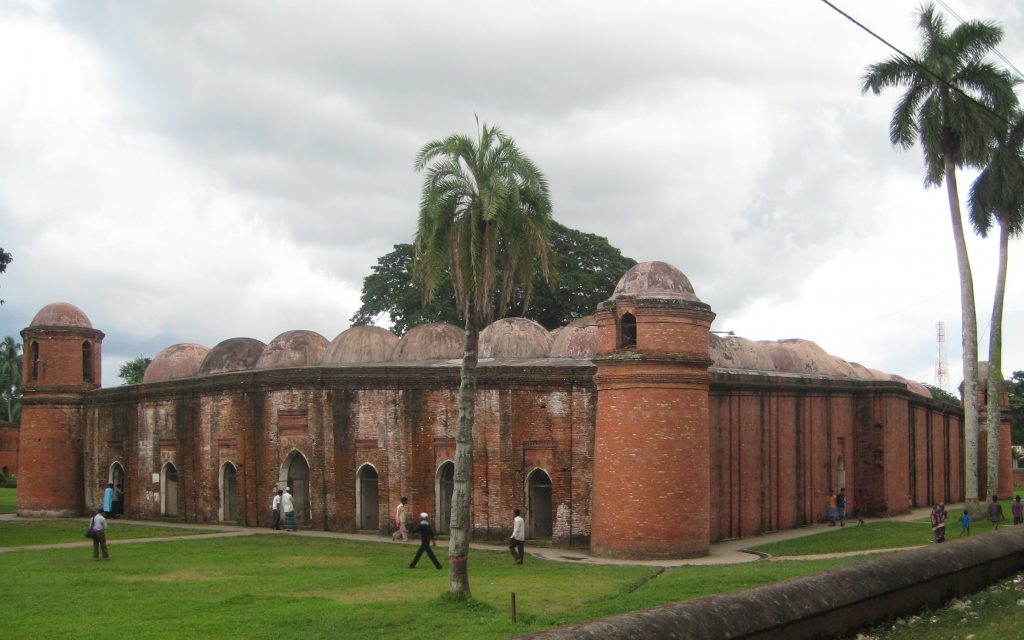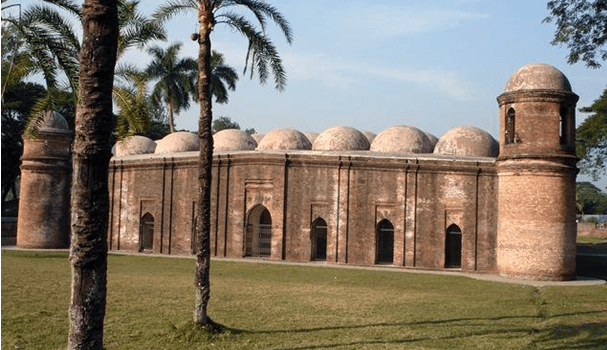The Shat Gambuj Mosque, also known as the Sixty Dome Mosque, is a historic mosque located in Bagerhat, Bangladesh. It stands as one of the most important and impressive examples of Islamic architecture in the region, and it is celebrated for its architectural grandeur and historical significance. The mosque was built in the mid-15th century by Khan Jahan Ali, a revered Muslim saint and the governor of the Sundarbans region under the Sultan of Bengal, Nasiruddin Mahmud Shah.
Architectural Grandeur and Unique Design
The ShatGambuj Mosque is renowned for its architectural beauty, which reflects the Indo-Islamic style prevalent during the Bengal Sultanate period. Contrary to what its name suggests, the mosque does not have sixty domes; instead, it features seventy-seven small domes arranged in seven rows of eleven, with the central aisle topped by four larger domes. The name “Shat Gambuj,” which translates to “Sixty Domes,” might have derived from a misinterpretation or a local tradition.
The mosque is constructed using terracotta bricks and is notable for its massive, rectangular structure. The building measures approximately 48.77 meters in length and 32.92 meters in width, making it one of the largest mosques of its time in the Indian subcontinent. The walls of the mosque are incredibly thick, with the exterior walls being nearly 2.5 meters wide, which not only supported the weight of the domes but also provided protection against the harsh climatic conditions of the region.
Slender Stone Columns and the Roof Structure
One of the most striking features of the ShatGambuj Mosque is the use of slender stone columns to support the roof. Inside the mosque, there are sixty stone pillars arranged in rows, which create an impressive grid of arches that support the domed roof. These stone columns are notable for their slenderness and height, and they are intricately carved with motifs typical of the Bengal Sultanate period. The pillars are not only functional, providing structural support, but also add to the aesthetic appeal of the mosque’s interior.
The roof of the mosque is one of its most distinctive features. The small domes that adorn the roof are arranged in such a way that they create a sense of rhythm and symmetry, which is both pleasing to the eye and architecturally significant. The central aisle, marked by the four larger domes, serves as the focal point of the mosque’s interior. These larger domes are more elaborately decorated and are supported by the central pillars, which are slightly thicker than the other pillars in the mosque.
The Vast Prayer Hall – Shat Gambuj Mosque
The Sat Gambuj Mosque boasts a vast prayer hall, which was designed to accommodate a large number of worshippers. The prayer hall is divided into seven aisles by the stone columns, creating a spacious and open interior that is illuminated by natural light filtering through the mosque’s small, arched windows. The floor of the mosque is made of terracotta tiles, which were laid out in geometric patterns that reflect the intricate design elements found throughout the mosque.
The prayer hall’s ceiling is relatively low, which, combined with the thick walls and small windows, gives the interior a sense of intimacy and tranquility, despite its large size. The arches that separate the aisles are slightly pointed, a characteristic feature of Islamic architecture in the Bengal region. The mihrab, or prayer niche, located on the western wall of the mosque, is elaborately decorated with intricate stone carvings and terracotta designs. It serves as the focal point for prayer and is oriented towards Mecca.
Historical Significance and UNESCO World Heritage Site
The Shat Gambuj Mosque is not only an architectural marvel but also holds great historical significance. It was part of the larger city of Khalifatabad, which was founded by Khan Jahan Ali and served as a major center of Islamic culture and administration in the region during the 15th century. The city was strategically located near the Sundarbans, the largest mangrove forest in the world, and played a crucial role in the spread of Islam in the region.
Khan Jahan Ali, the founder of the mosque, is revered as a saint and is credited with bringing Islam to the southwestern part of Bengal. He is also known for his efforts in developing the region, including the construction of roads, bridges, and other infrastructure that facilitated trade and communication. The Mosque stands as a testament to his legacy and the rich cultural and religious heritage of the region.
In 1985, the 60 Gambuj Mosque was designated as a UNESCO World Heritage Site, recognizing its outstanding universal value and its significance as a masterpiece of Islamic architecture. The UNESCO designation has helped to preserve the mosque and raise awareness about its importance as a cultural and historical landmark. The site attracts thousands of visitors each year, including both pilgrims and tourists who come to admire its architectural beauty and learn about its history.
Preservation and Challenges
Despite its status as a UNESCO World Heritage Site, the 60 Gambuj Mosque faces several challenges in terms of preservation. The mosque’s location in a region prone to flooding and heavy rainfall has led to concerns about the long-term stability of the structure. Additionally, the high humidity levels in the region have caused deterioration of the terracotta bricks and stone carvings, which are vulnerable to erosion and decay.
Efforts have been made to address these challenges, including restoration projects aimed at reinforcing the mosque’s structure and preserving its intricate architectural details. These efforts have been supported by both the Bangladeshi government and international organizations, including UNESCO, which has provided funding and expertise to ensure the mosque’s preservation for future generations.
Shait Gumbad Mosque is the largest of the Sultanate mosques in Bangladesh and one of the most impressive Muslim monuments in the whole of the Indian subcontinent. It is ascribed to one Khan al-Azam Ulugh Khan Jahan, who conquered the greater part of southern Bengal and named the area khalifatabad in honour of the reigning Sultan nasiruddin mahmud shah (1435-59). khan jahan ruled the region with the seat of administration at Haveli-Khalifatabad, identified with present Bagerhat, till his death in 1459.
Such a magnificent building turned into miserably decaying condition with the passage of time. It is however fortunate that the British government initiated measures for its restoration and repair and the process continued under the direct supervision of the successive Departments of Archaeology of Pakistan and Bangladesh. In the early 1980s an effective long-term programme was undertaken to safeguard this historical monument at the instance of UNESCO, and the work is nearing completion.
The most attractive part of the mosque is its large central nave, running east to west in a longitudinal line. This nave, consisting of seven independent oblong bays about 4.88m by 3.96m each, divides the interior of the mosque into two equal wings and opens out to north and south by pointed archways. The side wings are divided into square bays, numbering seventy in total. The square bays of the side wings, each measuring 3.96m on each side, are covered with inverted cup-shaped domes, while the oblong bays of the central nave are roofed over with chau-chala vaults. These vaults and cup-shaped domes are carried on intersecting arches springing from the pillars, and the corners between the arches are filled with characteristic Bengali pendentives. The building thus exhibits eighty-one domes in total – four on the corner towers, seventy over the side wings and seven chau-chala vaults over the central nave.
The north and south walls are internally marked with decorative cusped niches, twelve in each wall. Each of these niches is topped by a couple of mouldings. While these mouldings show rosettes alternating with diaper motifs, the space in between is ornamented with floral scrolls in terracotta.
An important feature of the mosque, though unusual in Bengal but noticed in many congregational mosques in northern India, is a small doorway in the back wall beside the central mihrab, the idea of which might have originally been borrowed from those of early mosques in Islam. In early Islam the postern opening of the mosque is known to have been used exclusively by the caliphs, governors or Imams. It is therefore not unlikely that the western doorway of the Shatgumbad Mosque was reserved for Khan Jahan, the governor of Khalifatabad, who had his residence a few yards away to the north of the mosque.
Of the two brick platforms, already cited, the one near the central mihrab was perhaps used by Khan Jahan while transacting administrative business, and the other near an eastern doorway was perhaps meant for a religious teacher, who sat on it and expounded Islamic teachings to the people or students. The Shatgumbad Mosque therefore appears to have served triple purposes – a congregational mosque, a parliament or assembly hall like those of early Islam and a madrasa like the Isfahan Jami and the Masjid-i-Jami at Ardistan in Persia.
The Shait Gambuj Mosque is a remarkable example of Islamic architecture and a symbol of the rich cultural and religious heritage of Bangladesh. Its unique design, characterized by slender stone columns, a vast prayer hall, and an array of domes, makes it one of the most significant mosques in South Asia. As a UNESCO World Heritage Site, the mosque continues to be a source of pride for the people of Bangladesh and an important destination for those interested in history, architecture, and religion.
The ongoing efforts to preserve and protect the Shat Gambuj Mosque ensure that this architectural masterpiece will continue to inspire awe and admiration for generations to come. Its historical significance, combined with its architectural beauty, makes it a true gem of the Bengal Sultanate period and a testament to the enduring legacy of Khan Jahan Ali.







